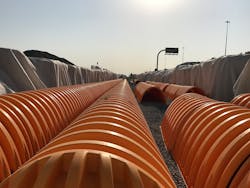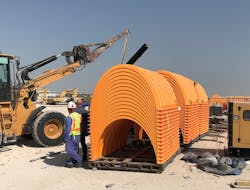Solving a Desert Deluge
Not an area immediately thought of as having problems with flooding, the Arabian Peninsula desert does endure severe rain events several times a year. Doha, the capital city of Qatar, can often receive a year’s worth of rain in a day, causing flooding, especially on its roads and underpasses. While planning the Muntazah Street improvement project in preparation for hosting the 2022 FIFA World Cup Qatar and as part of the Qatar National Vision 2030 Program, Ashghal, the Public Works Authority of Qatar, called for an underground system to hold stormwater runoff from the expanded highway. The total system would have to be capable of holding nearly 800,000 Imperial gallons (960,000 US gallons) of water.
The Al Muntazah Street Extension Project, which started in 2010 and was completed in 2019, is a major highway upgrade and improvement project. Construction included approximately eight 8 kilometers (4.9 miles) of new two-lane highway on Abu Hamour Road from East Industrial Interchange to Woqod Interchange and approximately two 2 kilometers (1.25 miles) of two-lane highway on F-Ring Road from Woqod Interchange to Al Jazeera Interchange. The work included highways and highway structures, four interchanges, underpasses, bridge structures and flyovers, potable water supply systems, irrigation distribution systems, a wastewater system with pumping station, surface and groundwater drainage system, electricity networks, substations, a telecommunications network, street signs, and traffic signals. The wide roadway also provides more surface area for rain to flow into the new stormwater drainage system.
The original plans for the stormwater control system called for a network of crates to be installed. These 610 by 610 millimeters (24 by 24 inches) multi-component boxes could not, however, provide the infiltration area called for in the engineer’s calculations. Instead, a system of arch-shaped chambers in multiple tanks would be buried with up to 3.96 meters (13 feet) of cover.
The new stormwater management system consists of 20 separate infiltration tanks with a total of 7,161 StormTech MC-3500 Chambers that can hold a total volume of 42,765 cubic meters (1,510,231 cubic feet) of water. StormTech chambers are a product of Advanced Drainage Systems Inc. (ADS) based in Hilliard, OH. Coordination of delivery along with technical assistance was provided by ADS distributors Cubic M3 (Dublin, Ireland) and WT Burden (Doha, Qatar).
The StormTech chambers were installed in 2018 by Al Jaber & Partners W.L.L. (Doha, Qatar), in rectangular trenches alongside 5 kilometers (3.10 miles) of the new road. The chambers are designed in accordance with AASHTO, ASTM, CSA, and European design standards, qualifying them for use in commercial and municipal projects. Made from an engineered grade of impact-modified polypropylene copolymer, the chambers have a 75-year service life. Each chamber, without end caps, measures 2286 millimeters (90 inches) long by 1956 millimeters (77 inches) wide by 1143 millimeters (45 inches) high and has an installed volume of 5.06 cubic meters (178.7 cubic feet) of water.
Along the sides and on top of the chambers, the equivalent of ADS 0601TG non-woven geotextile was used as a soil separation layer. Underneath the chambers, woven geotextile was used to add scour protection.
For the removal of total suspended solids (TSS), a StormTech Isolator Row was incorporated into each tank unit. This section will trap sediment from the stormwater drainage, preventing it from settling at the bottom of the bed, which would slow the infiltration rate. The Isolator Rows can be cleaned out by a JET-VAC process using access from any one of the inspection/cleanout ports.“Unlike in the United States and Europe where there are regular rains,” explains Karim Amin, ADS Export Sales Manager, “in the Middle East, it’s just the opposite. It’s dry most of the year but when it rains, they get hit with a higher intensity storm in a short period. It might rain only three or four times a year, but they might get more than 100 millimeters (4 inches) of rain in a period of two hours. So, they end up getting massive amounts of rain in a smaller timeframe. That’s why they need the stormwater management system, to control flooding in those areas.”
According to Arab News, a major English-language newspaper in the region, extreme weather conditions on October 20, 2018, made roads impassable; flooded tunnels, universities, schools, clinics, embassies, and the new national library; and closed shops, some for several days, as 84 millimeters (3 inches) of rain fell.
The average annual rainfall for Doha is 76 millimeters (3 inches). During the month of October, the average is just 1.1 millimeters (1/4 inch). In Education City, a Doha suburb where a 2022 World Cup stadium will be located, official figures showed an astonishing 98 millimeters (3.85 inches) of rain fell. The Ministry of Municipality and Environment’s Rainfall Emergency Committee said that 287 million gallons of rainwater were subsequently removed.
Social media showed rainwater running down staircases inside buildings, parked cars all but submerged, and people using jet skis on main roads usually used by cars. The extreme conditions were exacerbated by Qatar’s terrain, causing drainage problems. “If you get heavy rain in the desert it often floods quite quickly because the sand is baked hard in the sun and there’s not much vegetation (to help with drainage),” says former Al Jazeera Senior Meteorologist Steff Gaulter.
Prior to the installation of the underground system, excess water would be removed using pumper trucks that would then carry the water away. Now, the stormwater flows into the underground chambers and slowly percolates into the soil.
In Doha, the normal high from mid-June to early July is 41.3°C (106°F), increasing to 41.5°C (107°F) for the rest of July. Due to this extreme heat, the World Cup has been moved to winter from the traditional late spring, the first time the tournament date has ever been changed.
While the StormTech Chamber meets or exceeds all appropriate industry standards, additional evaluations were requested to assure that its integrity would be maintained and not be affected by the heat, even though they would be buried underground. ADS undertook an additional schedule of finite element analysis (FEA) to honor that request.
“Most standards in both the United States and internationally require structural evaluations to be conducted at 23°C (73°F),” says David Mailhot, P.E., technical director, StormTech. “For the Qatar project, we increased that to 40°C (104°F) and provided the documentation of the successful evaluation. The additional site-specific evaluation was necessary to ensure proper structural performance under the combined demands of deep cover and elevated temperature. Despite the deep cover, live load effects were also considered in the structural evaluation. Plus, manufacturing and logistics plans were arranged based on the client’s requirements and all material had to be produced from the same material source with quality certificates for each shipment. There was were also onsite training sessions and a supervision program for the contractor’s team.”
“Since the system was completed at the end of summer 2018,” Amin says, “they’ve had rainstorms and the systems worked perfectly. It’s right next to an underpass, and there was no ponding or flooding of the underpass.



